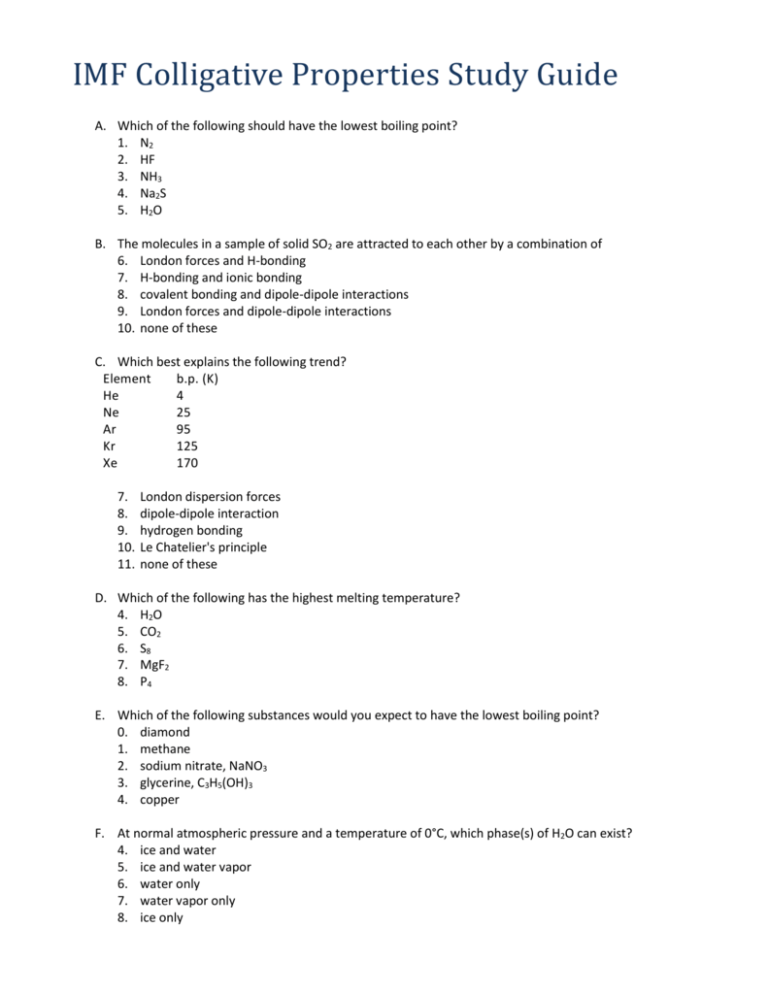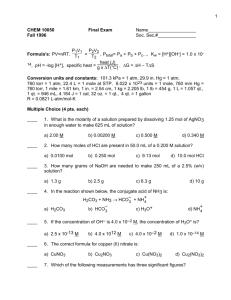IMF Colligative Properties Study Guide Which of the following
advertisement

IMF Colligative Properties Study Guide A. Which of the following should have the lowest boiling point? 1. N2 2. HF 3. NH3 4. Na2S 5. H2O B. The molecules in a sample of solid SO2 are attracted to each other by a combination of 6. London forces and H-bonding 7. H-bonding and ionic bonding 8. covalent bonding and dipole-dipole interactions 9. London forces and dipole-dipole interactions 10. none of these C. Which best explains the following trend? Element b.p. (K) He 4 Ne 25 Ar 95 Kr 125 Xe 170 7. 8. 9. 10. 11. London dispersion forces dipole-dipole interaction hydrogen bonding Le Chatelier's principle none of these D. Which of the following has the highest melting temperature? 4. H2O 5. CO2 6. S8 7. MgF2 8. P4 E. Which of the following substances would you expect to have the lowest boiling point? 0. diamond 1. methane 2. sodium nitrate, NaNO3 3. glycerine, C3H5(OH)3 4. copper F. At normal atmospheric pressure and a temperature of 0°C, which phase(s) of H2O can exist? 4. ice and water 5. ice and water vapor 6. water only 7. water vapor only 8. ice only G. Given below are the temperatures at which two different liquid compounds with the same empirical formula have a vapor pressure of 400 torr. Compound T (°C) dimethyl ether, CH 3–O–CH3 –37.8 ethanol, CH 3CH2OH 63.5 Which of the following statements (a–d) is false? 4. 5. 6. 7. Increasing the temperature will increase the vapor pressure of both liquids. Intermolecular attractive forces are stronger in (liquid) ethanol than in (liquid) dimethyl ether. The normal boiling point of dimethyl ether will be higher than the normal boiling point of ethanol. The reason that the temperature at which the vapor pressure is 400 torr is higher for ethanol (than for dimethyl ether) is that there is strong hydrogen bonding in ethanol. 8. None of these is false. H. Generally the vapor pressure of a liquid is related to: I. the amount of liquid II. atmospheric pressure III. Temperature IV. intermolecular forces 5. 6. 7. 8. 9. I. J. I, III II, III, IV I, III, IV III, IV I, II, III, IV How would you expect the melting point of CF4 to compare to that of RbF? 1. It should be lower because RbF forms an extended ionic crystal lattice ,whereas CF4 is a covalentlybonded small molecule. 2. It should be similar since they are both ionic solids. 3. It should be higher because the bonds are stronger due to the higher charge on C (+4). 4. It should be higher because CF4 is larger than RbF. 5. It is not possible to say anything about their melting points without more information. How many grams of ice would be melted by the energy obtained as 22.8 g of steam is condensed at 100°C and cooled to 0°C? specific heat (ice) = 2.10 J/g°C specific heat (water) = 4.18 J/g°C heat of fusion = 333 J/g heat of vaporization = 2258 J/g 6. 7. 8. 9. 10. 61.0 kg 51.5 kg 183 g 9.53 kg 29 g K. The triple point of iodine is at 90 torr and 115°C. This means that liquid I2 4. is more dense than I2(s) 5. cannot exist above 115°C 6. cannot exist at 1 atmosphere pressure 7. cannot have a vapor pressure less than 90 torr 8. can exist at pressure of 10 torr L. Below is a phase diagram for compound Q. You wish to purify a sample of Q that was collected at P = 1.0 atm and T = 100 K by subliming it. In order to sublime the sample, you should: 0. 1. 2. 3. 4. Increase P to 1.5 atm and then increase T to 300 K. Increase T to 300 K, keeping P = 1.0 atm. Lower P to 0.5 atm and then increase T to 200 K. Increase T to 300 K and then lower P to 0.5 atm. Abandon the attempt to sublime Q. M. Given the phase diagram below, which of the following statements (A–D) is false? 5. The solid has a higher density than the liquid. 6. At some (constant) temperature, the gaseous substance can be compressed into a solid and then into a liquid in this order. 7. When phase A is compressed at constant temperature at point X, no change is observed. 8. When heated at 1 atm, this substance will first melt, then boil. 9. None of the above statements is false. N. 1.69 L of an aqueous solution containing 25.00 g of KCl dissolved in pure water is prepared. The molarity of the solution is: 6. 0.198 M 7. 14.8 M 8. 5.04 M 9. 0.397 M 10. 0.0992 M O. Calculate the molality of C2H5OH in a water solution that is prepared by mixing 50.0 mL of C2H5OH with 108.4 mL of H2O at 20°C. The density of the C2H5OH is 0.789 g/mL at 20°C. (Assume the density of water at this temperature is 1.00 g/mL.) 4. 0.0100 m 5. 0.149 m 6. 0.127 m 7. 7.90 m 8. 10.0 m P. If 2.00 g of helium gas and 5.46 g of oxygen gas are mixed together, what is the mole fraction of helium in the solution? 5. 0.268 6. 0.255 7. 0.745 8. 0.171 9. 1.34 Q. Calculate the molarity of a solution of magnesium chloride with a concentration of 22.7 mg/mL. 8. 0.477 M 9. 0.238 M 10. 0.119 M 11. 4.19 M 12. 0.380 M R. Which of the following favors the solubility of an ionic solid in a liquid solvent? 5. a large magnitude of the solvation energy of the ions 6. a small magnitude of the lattice energy of the solute 7. a large polarity of the solvent 8. all of the above 9. none of the above S. A solution is prepared from 76.4 g of a nonvolatile, nondissociating solute and 85.0 g of water. The vapor pressure of the solution at 60°C is 132 torr. The vapor pressure of water at 60°C is 150. torr. What is the molar mass of the solute? 0. 86.8 g/mol 1. 16.2 g/mol 2. 49.1 g/mol 3. 208 g/mol 4. 119 g/mol Use the following to answer questions T - V: For each of the following solutions, describe the deviation with respect to Raoult's Law. T. hexane (C6H14) and chloroform (CHCl3) 8. relatively ideal 9. positive deviation 10. negative deviation 11. more information needed 12. none of these U. acetone (C3H6O) and water 4. relatively ideal 5. positive deviation 6. negative deviation 7. more information needed 8. none of these . V. hexane (C6H14) and octane (C8H18) 8. relatively ideal 9. positive deviation 10. negative deviation 11. more information needed 12. none of these W. The freezing point (Tf) for t-butanol is 25.50°C and Kf is 9.1°C/m. Usually t-butanol absorbs water on exposure to the air. If the freezing point of a 11.9-g sample of t-butanol is measured as 24.59°C, how many grams of water are present in the sample? 0. 0.10 g 1. 0.021 g 2. 10. g 3. 2.1 g 4. 21 g X. A 6.54-gram sample of a compound is dissolved in 250. grams of benzene. The freezing point of this solution is 1.02°C below that of pure benzene. What is the molar mass of this compound? (Note: Kf for benzene = 5.12°C/m.) Ignore significant figures for this problem. 2. 32.8 g/mol 3. 131 g/mol 4. 263 g/mol 5. 5.21 g/mol 6. 65.7 g/mol Y. A solute added to a solvent raises the boiling point of the solution because: 8. The temperature to cause boiling must be great enough to boil not only the solvent but also the solute. 9. The solute particles lower the solvent's vapor pressure, thus requiring a higher temperature to cause boiling. 10. The solute particles raise the solvent's vapor pressure, thus requiring a higher temperature to cause boiling. 11. The solute increases the volume of the solution, and an increase in volume requires an increase in the temperature to reach the boiling point (derived from PV = nRT). 12. Two of the above are correct.











